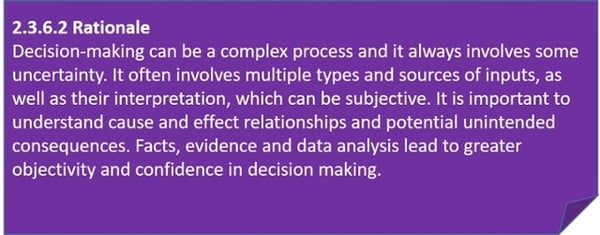6. Evidence Based Decision Making
This principle relates to the idea that effective decisions are based on the analysis of data and information, rather than guess-work or instinct. Applying this principle to quality management may involve:
- Collecting data and information relevant to the objective
- Ensure the data and information gathered is accurate, reliable and accessible
- Ensure the analysis of this data and information is done using valid methods – this involves understanding the value of suitable statistical techniques
- Use these results of logical analysis paired with intuition and experience to make informed decisions
For many organisations, this principle can be a tricky one to get right. When you consider the hundreds of decisions that are made every single day by workers, management and Boards, that’s a lot of scope for getting things wrong.
It’s so very easy for businesses to eventually find themselves in an unproductive position, wondering how on earth they arrived there. Well, unfortunately that’s the cumulative result of many thousands of decisions made with poor information, gut-instinct or around personalities. You reach a dead-end many miles from where you were aiming.
Creating a culture of evidence-based decision making isn’t easy, and ISO 9000 recognises this:

With such complex systems it’s vital you collect data and to use it to make decisions every single day.
Don’t let data passively reside in spreadsheets or databases, instead you use it to drive action.
It should be key in shaping your continuous improvement initiatives. The collection of data and evidence, and then doing analysis based on that data and evidence, is key. But – and here’s the trick - you must collect the right data.
One of Mango’s clients put the collection of data first and foremost when it developed its quality management processes. Each process must collect data and present it in such a way that is readable and understandable by the shop floor staff. To do this they use display boards in each department showing things like control charts, check sheets, action lists and problem sheets. The staff enter the data themselves and can easily see if processes are in or out of control. With the relevant and up-to-date data placed exactly where it’s needed, decisions are made quickly and accurately.
To give you a visual, the company has moved its quality management system from this:

To this:

This change in approach has reduced the number of internal quality non-conformances and customer complaints. Money has been saved and profits have increased. The business has deftly avoided the pitfalls of shonky decision-making.
The other Quality management Principles are:
- Customer Focus
- Leadership
- Engagement of people
- Process Approach
- Improvement
- Relationship Management



